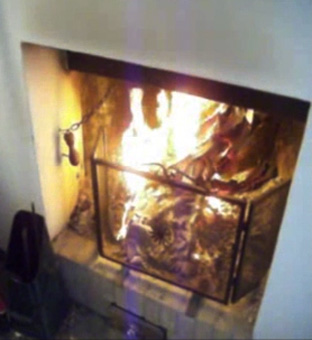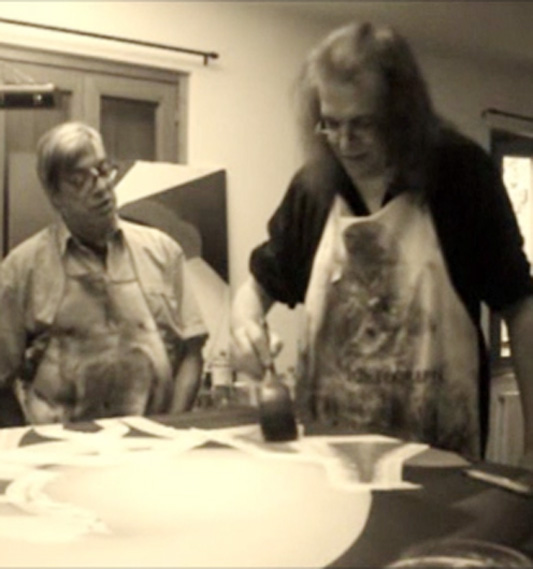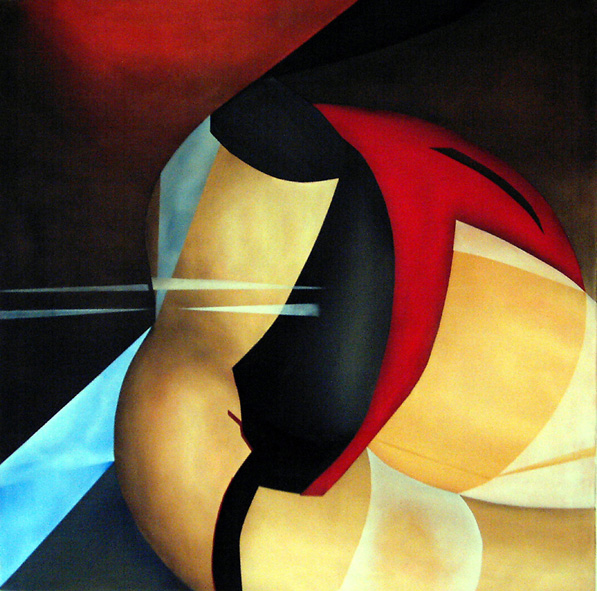
I CONTEMPORANEI 3000
PRESENTANO:
presentano:
Giorgio VALENTINUZZI

CHE COSA FACCIO QUANDO DIPINGO
(WHAT DO I DO WHEN I PAINT)

CHE COSA FACCIO QUANDO DIPINGO
di Giorgio Barassi:

Il caminetto fa la sua parte, mentre Valentinuzzi lavora e parla, si arrabbia, dialoga con Edi, il suo aiutante. Il mondo della creazione pittorica ha un suo rituale, ben diverso da quello dell’ immaginario collettivo. Non ci sono pittori in camice bianco...e basco largo. Non ci sono pittori che sanno di poesia a un metro di distanza. Non ci sono pittori. E quelli che ci sono, “fanno”, quando dipingono. Corredando la propria azione creativa con la nostalgia cantata da un altoparlante che sa di Al Bowlly, Billie Holiday ed altri eroi. Lo scenario è chiuso dai dialoghi, tra parole mozzicate e qualche citazione, come quel “ Gropius “ che esce dalla bocca del maestro come una bestemmia da una bocca toscana...ma che bel culo, maestro! Hai ragione, caro Valentinuzzi, qualcuno ha detto che la pittura è una commedia che si consuma con dolore...per dirlo aveva tempo, evidentemente. Condivido in pieno il tuo parere, assolutamente. Differenza tra poesia e pittura? Leonardo diceva...diceva che l’una (la poesia) arriva al cuore attraverso il senso meno nobile (l’udito). La pittura vi arriva attraverso il senso più nobile (la vista). Io dico che la pittura italiana, per ciò che comprende, ha bisogno di eroi e non di chiacchieroni. Oggi questi ultimi sono abbondanti ed eccedenti la misura. La breve e intensa durata di uno di questi episodi allinea la creatività di Valentinuzzi a quella di certi informali. La brevità dell’ operazione artistica come fatto che testimonia l’essenziale. Di bello e vero c’è che Valentinuzzi concretizza in quei pochi attimi le attese creative di una vita che si dispone al nostro sguardo tra tavolo, schermo, carte, oggetti...come un modo per dire che lui é lì, é e sarà così e non cambia. Questo é dei grandi artisti. Onore al merito ! “...col penelòn te lo meto nel furgòn...” “...perchè el nero sporca el cùl...” So che il mio intervento è ormai minimo, al cospetto del fiorire di critici e commentatori d’ arte, ma voglio solo dire che nei dialoghi c’è il completamento de...ll’ atto creativo, l’umanità sognante che esce da quei canoni in cui abbiamo tutti ingabbiato il fatto della creazione artistica. Con Valentinuzzi capiamo che Michelangelo bestemmiava col Ghirlandaio, che Piero mandava affanculo il ragazzo di bottega, che Mantegna inveiva in mantovano “..la vàca...” verso chi chiedeva invece di eseguire...questa è la vera pittura! Un artista che non bestemmia non vale molto. Vuol dire che tutto gli viene come lo pensa, che tutto va come lui vuole o inventa...impossibile! “Guarda quanto colore per fare un culo”. L’amara constatazione del creatore verso la sua creatura dà il senso della eterna lotta tra la ragione e l’ istinto, un’altra delle motivate forme costitutive del lavoro di Valentinuzzi: un grande artista in un mondo troppo piccolo.
The fireplace does its part, while Valentinuzzi works and speaks, he gets angry, talks to Edi, his aide. The world of artistic creation has its own ritual, quite different from that of 'collective imagination. There aren't painters...in a white coat and beret off. There aren't painters who know the poem to a meter away. There aren't painters. And there are those who "do" when they re painting. Adding to the creative action with nostalgia sung by a speaker who knows Al Bowlly, Billie Holiday and other heroes. The scene is closed by the dialogues between half-words and a few quotes, as that "Gropius" which comes from the mouth of the Maestro as a blasphemy by a Tuscan mouth...what a beautiful ass, Master! You're right, dear Valentinuzzi, someone said that painting is a comedy that is consumed with grief...that had time to say it, obviously. I absolutely fully share your opinion. What's the difference between poetry and painting? Leonardo Da Vinci said...he said that the one (poetry) reaches the heart through the less noble sense (hearing). The painting comes to you through the noblest sense (sight). I say that the Italian painting, for what it includes, in need of heroes and not talkative. Today they are abundant and exceeding the measure. The short and intense duration of one of these episodes aligns the creativity of Valentinuzzi to that of certain informal. The brevity of 'artistic work as a fact that testifies to the essential. The beautiful and true is that in those few moments Valentinuzzi concrete expectations of a creative life that you have to look between our table, screen, paper, objects...as a way of saying that he is there, it's and will and so does not change. This is of great artists. Honor is due! "...col penelòn te lo meto nel furgòn...” “...perchè el nero sporca el cùl...” I know that my speech is now at least, the sight of the blooming of critics and commentators d 'art, but I just want to say that in the dialogues is the completion of...the creative act, the humanity that comes from dreaming these canons in which we are all trapped because of artistic creation. With Valentinuzzi we can understand that Michelangelo swore by Ghirlandaio, Piero Della Francesca sent to fuck the guy in the shop, which Mantegna in Mantua railed ".. la vaca ..." instead of running to those who asked...this is the real painting! If an artist don't swears he is not worth much. It means that everything is as we think, that everything goes as he wants or invented...impossible! "Look at how much color to make a butt". The bitter realization of the creator towards his creature gives a sense of the eternal struggle between reason and the 'instinct of another motivated constitutive forms of work by Valentinuzzi: a great artist in a world too small.
nella confezione c'è un libretto che contiene la parte critica scritta da Carlo Milic, un commento particolare di Giorgio Barassi, alcuni dei commenti degli amici di fb che han visionato tutti i 43 episodi della soap painting opera: "Che cosa faccio quando dipingo", dei dialoghi intercorsi tra l'autore ed il suo aiutante Edi Cola Antoniolo e delle immagini...
in the packaging there's a booklet that contains the critical part written by Carlo Milic, a special comment by Giorgio Barassi, some of the comments of fb friends who have watched all 43 episodes of the painting soap opera : "What do I do when I paint" ; parts of the conversations between the author and his assistant, Edi Cola Antoniolo and various images....
quella che vi darò non è una notizia che potrà cambiare il mondo, ma è pur sempre una notizia!
I will give you a story that surely will not change the destinies of the world, but it is definitely a good news!!!

($ 13.39)
+ spese di spedizione
(per l'italia Euro 1,50)
DVD Single in caso standard
Weight: 4-5 ounces Peso: 4-5 once
Canada: $1.70 - $1.95 Canada: $ 1.70 - $ 1,95
Europe: $4.20 - $5.05 Europa: $ 4.20 - $ 5,05
Asia/Australia: $4.65 - $5.60 Asia / Australia: $ 4,65 - $ 5,60
2 DVDs in standard case 2 DVD
in caso di serie
Weight: 6-7 ounces Peso: 6-7 once
Canada: $2.20 - $2.50 Canada: $ 2.20 - $ 2,50
Europe: $5.90 - $6.75 Europa: $ 5,90 - $ 6,75
Asia/Australia: $6.55 - $7.50 Asia / Australia: $ 6,55 - $ 7,50
Sul retro della scatola che contiene
ogni dvd c'è un bollino con un numero progressivo che attesta l'avvenuta
registrazione alla S.I.A.E.;
On the back of the box that contains each DVD there is a sticker with a serial
number which certifies the registration of SIAE;
tra tutti i possessori del dvd "che cosa faccio quando dipingo", sulla base del numero progressivo di serie, noi estrarremo a sorte 8 premi.
among all the holders of the DVD "What do I do when I paint" on the basis of the
'serial number, we will pull out of lots 8 awards.
il primo premio consiste in un dipinto dal titolo "forma plastica"
del Maestro Giorgio Valentinuzzi,
cm 100x100, olio su tela, 2012.

by Maestro Giorgio Valentinuzzi,
100x100 cm, oil on canvas, 2012.
l'elenco degli
altri sette premi verrà comunicato prossimamente
Event n. 111
Org., ricerche, testi, inviti, comitato scientifico, prog.
grafico, marchio, impaginazione,stampa, pagina web,
video e dialoghi, rev. testi, eventuali errori:
Giorgio Valentinuzzi
Organization, research, books, invitations,
Scientific, graphic design,
logo, layout, printing, web page,
video and speech, proofreading,
errors:
Giorgio Valentinuzzi
La foto del M.o Giorgio Valentinuzzi è di
Marianna Azzolini
Photo of M.o Giorgio Valentinuzzi
is by Marianna Azzolini
Comunicato stampa:
Rodolfo Rudy CozziPress Release: Rudolph Rudy Cozzi
Altri testi:
Giorgio Barassi & Giorgio Valentinuzzi
per info:
0432 44444
info@icontemporanei.it